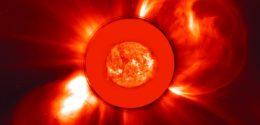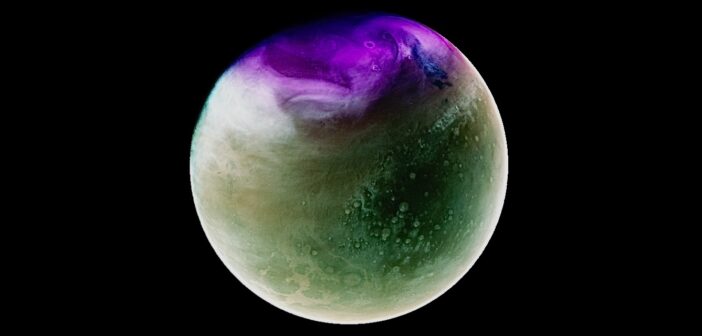As the Sun’s magnetic activity cycle ramps up, solar storms are brewing. A recent research article describes what two Mars-orbiting spacecraft saw when a solar storm struck the red planet.

This image from the Solar and Heliospheric Observatory shows two coronal mass ejections during an event in November 2000. [ESA/NASA/SOHO]
Storms from the Sun
The Sun’s atmosphere is suffused with pent-up magnetic energy that periodically escapes, powering coronal mass ejections (CMEs): immense eruptions of plasma and magnetic fields. CMEs are common — the frequency varies from about 50 a year when the Sun is at its calmest to more than 1,000 a year at the peak of the Sun’s activity cycle — but only a small fraction of these storms strike the planets in our solar system.
When a CME strikes Earth, it disturbs and compresses our planet’s protective magnetic shield and creates brilliant auroras. While Earth has a strong global magnetic field to shield our atmosphere from these storms, other planets are not as fortunate. Mars has feeble magnetic fields buried in some of its crust, perhaps a remnant of a stronger and larger magnetic field from long ago, but its atmosphere is largely unprotected. How solar activity like CMEs affects the atmosphere of Mars is important for our understanding of how the red planet’s atmosphere and habitability has evolved over billions of years.
Day and Night
On 4 December 2021, a CME burst from the Sun. Two days later, it swept past the BepiColombo spacecraft, which was surfing through the solar wind after passing close to Mercury for the first time, and charged toward Mars. There, two spacecraft stood at the ready: Tianwen-1 and MAVEN. When the CME reached Mars on 10 December 2021, Tianwen-1 witnessed the impact head on from its vantage point on the sunlit side of the planet. MAVEN took notes from the night side, spared the direct impact of the CME but positioned to witness how its effect propagated around the planet.

An illustration of the orbits of the Tianwen-1 and MAVEN spacecraft during the CME’s passage. Tianwen-1 sampled the day side atmosphere while MAVEN measured the night side atmosphere. BepiColombo witnessed the event from much closer to the Sun. Click to enlarge. [Yu et al. 2023]
Under normal conditions, some ionospheric plasma travels around the planet to its night side. What MAVEN witnessed as the CME raged on was notably different: a major decrease in the number of ions present in the shadow of the planet. This decrease suggests that rather than swinging around to the night side, the ions were escaping the atmosphere altogether, swept downstream by the CME.
Escape of Martian Plasma

Summary of the effects of the interplanetary CME (ICME) on Mars’s ionosphere. The density of the ionospheric plasma, shown by the solid lines, dipped, and the ionopause — the altitude above with the plasma density drops off sharply — was pushed lower day by day. Click to enlarge. [Adapted from Yu et al. 2023]
Since only a small fraction of Mars’s atmosphere is ionized, this means the CME stole just a tiny amount of the atmosphere — but the compounded effects of CMEs over billions of years could be huge; the theft of ions likely shaped the evolution of Mars’s atmosphere, playing a role in transforming our neighboring planet from one that was warm and hospitable to the unforgiving, arid world it is today.
Citation
“Tianwen-1 and MAVEN Observations of the Response of Mars to an Interplanetary Coronal Mass Ejection,” Bingkun Yu et al 2023 ApJ 953 105. doi:10.3847/1538-4357/acdcf8

